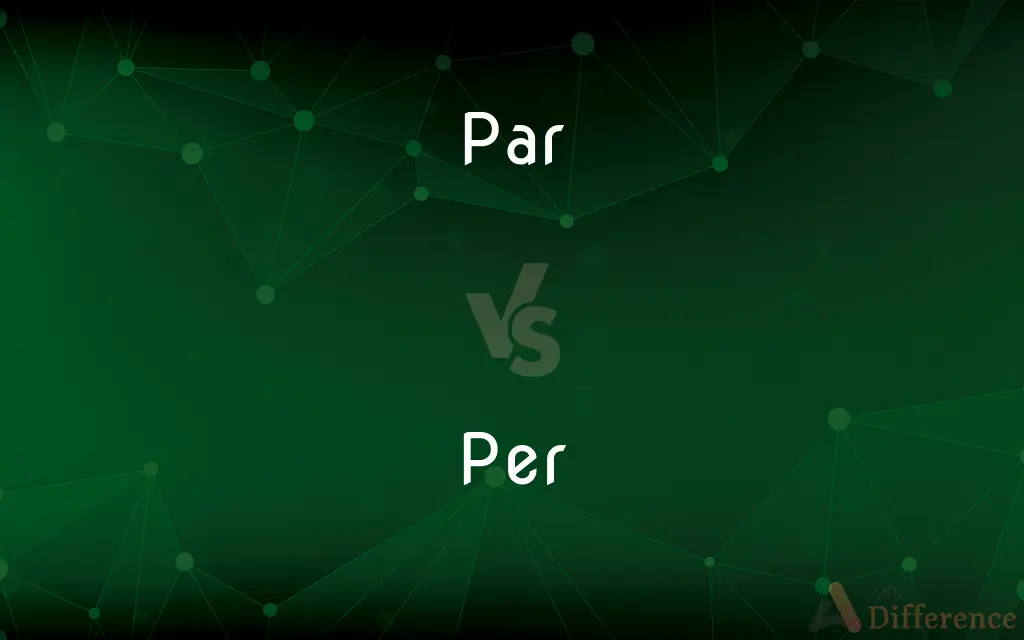Par vs. Per — What's the Difference?
By Urooj Arif & Fiza Rafique — Updated on March 31, 2024
Par denotes a standard level of achievement or condition, while per signifies for each, indicating a rate or distribution. Par is about meeting a standard; per is about allocation.

Difference Between Par and Per
Table of Contents
ADVERTISEMENT
Key Differences
Par represents a benchmark or standard that is considered normal or expected, especially in the context of finance or sports. For example, in golf, par is the number of strokes a skilled player is expected to make to complete a hole or course. On the other hand, per is used to express a rate or ratio, denoting the idea of for each or according to. It is commonly used in various contexts to indicate distribution or allocation, such as per capita income or miles per hour.
While par is used to describe a level of proficiency or quality that matches a certain standard, it is not necessarily about quantification or measurement in terms of units or distribution. Whereas, per explicitly deals with measurements, often used to indicate how something is divided or allocated among a number of units, like pricing (e.g., price per item) or distribution (e.g., calories per serving).
Par can also signify equality or equivalence in terms of value, especially in finance, where it can indicate the face value of a bond or stock is equal to its market value. In contrast, per is predominantly a preposition used to describe the relation between a part and a whole, focusing on the distribution aspect, such as per liter or per kilogram, which has no direct implication of equality or standardization.
In the context of performance or achievement, reaching par means achieving the expected standard, not more or less. This concept is crucial in sports and performance assessments, where it represents a goal or benchmark. Per, however, relates to the method of quantifying or measuring performance, achievements, or distribution, emphasizing a comparative or relational perspective rather than an absolute standard.
Par and per, while both can relate to standards and measurements, diverge significantly in their core meanings and applications. Par focuses on achieving or equating to a set standard, emphasizing equivalence or adequacy. Per, on the other hand, is about the rate or method of division or allocation, highlighting a proportional or relational understanding.
ADVERTISEMENT
Comparison Chart
Definition
A standard level or condition
For each, indicating rate or distribution
Context
Finance, sports, performance standards
Measurements, rates, allocations
Key Connotation
Achievement of a standard, equivalence
Distribution, ratio, or rate per unit
Example Usage
Par in golf, par value of bonds
Miles per hour, cost per item
Relation to Standards
About meeting or equating to a standard
About quantification or measurement relative to units
Compare with Definitions
Par
A standard number of strokes in golf.
He finished the course three under par.
Per
By means of.
They traveled per airplane.
Par
A state of equality.
Your performance is on par with your peers.
Per
According to.
Per your instructions, we have updated the report.
Par
Face value of a security.
The bonds were issued at par.
Per
For each or for every.
The cost is $10 per person.
Par
An expected standard.
The service at the restaurant was below par.
Per
By the.
The vehicle was moving at 60 miles per hour.
Par
A level of average condition.
The quality of these goods is just at par.
Per
Used to express rates.
The milk is sold per liter.
Par
The number of strokes a first-class player should normally require for a particular hole or course
Woosnam had advanced from his overnight position of three under par
The sixteenth is a par five
Per
For each (used with units to express a rate)
He charges £2 per square yard
Par
The face value of a share or other security, as distinct from its market value
Par value
The 9 per cent unsecured loan stock is redeemable at par
Per
By means of
Send it per express
Par
A paragraph
Fifteen pars on the front page
Per
Divided by a line in the direction of
Per saltire
Par
Play (a hole) in par
He calmly parred the 17th
Per
To, for, or by each; for every
Gasoline once cost 40 cents per gallon.
Par
An amount or level considered to be average; a standard
Performing up to par.
Did not yet feel up to par.
Per
According to; by
Changes were made to the manuscript per the author's instructions.
Par
An equality of status, level, or value; equal footing
A local product on a par with the best foreign makes.
Per
By means of; through.
Par
The established value of a monetary unit expressed in terms of a monetary unit of another country using the same metal standard.
Per
For each one; apiece
Sold the cookies for one dollar per.
Par
See par value.
Per
Per hour
Was driving at 60 miles per.
Par
(Sports) The number of golf strokes considered necessary to complete a hole or course in expert play.
Per
For each.
Admission is £10 per person.
Miles per gallon
Beats per minute
$2.50 per dozen
Par
To score par on (a hole or course) in golf.
Per
To each, in each (used in expressing ratios of units).
12 inches per foot
100 centimeters per meter
Par
Equal to the standard; normal
A solid, par performance.
Per
(medicine) By the, by means of the, via the, through the.
Introduce the endoscope per nasum.
The medication is to be administered per os.
Par
Of or relating to monetary face value.
Per
In accordance with, as per
I parked my car at the curb per your request.
Implement a program that computes the approximate grade level needed to comprehend some text, per the below.
Note that while the walkthrough illustrates that words may be separated by more than one space, you may assume, per the specifications above, that no sentences will contain more than one space in a row.
Par
Abbr of paragraph
Per
They singular. Gender-neutral neologistic third-person singular subject pronoun, coordinate with gendered pronouns she.}}
Par
Abbr of parenthesis
Per
Them singular Neologistic gender-neutral third-person singular object pronoun, suggested for use in place of her.}}
Par
Abbr of parish
Per
Belonging to per, their singular. Gender-neutral third-person singular possessive adjective, coordinate with gendered her.}}
Par
Equal value; equality of nominal and actual value; the value expressed on the face or in the words of a certificate of value, as a bond or other commercial paper.
Per
Through; by means of; through the agency of; by; for; for each; as, per annum; per capita, by heads, or according to individuals; per curiam, by the court; per se, by itself, of itself. Per is also sometimes used with English words.
Par
Equality of condition or circumstances.
Par
The allotted number of strokes to reach the hole.
He needs to make this shot for par.
Par
A hole in which a player achieves par.
Par
(UK) An amount which is taken as an average or mean.
Par
Abbr of parallel
Par
(in compounds) By; with.
Par
To reach the hole in the allotted number of strokes.
He will need to par every hole in order to win this game.
Par
To associate, to chill, to hang.
Par
See Parr.
Par
Equal value; equality of nominal and actual value; the value expressed on the face or in the words of a certificate of value, as a bond or other commercial paper.
Par
Equality of condition or circumstances.
Par
An amount which is taken as an average or mean.
Par
The number of strokes required for a hole or a round played without mistake, two strokes being allowed on each hole for putting. Par represents perfect play, whereas bogey makes allowance on some holes for human frailty. Thus if par for a course is 75, bogey is usually put down, arbitrarily, as 81 or 82. If par for one hole is 5, a bogey is 6, and a score of 7 strokes would be a double bogey.
Par
By; with; - used frequently in Early English in phrases taken from the French, being sometimes written as a part of the word which it governs; as, par amour, or paramour; par cas, or parcase; par fay, or parfay.
Par
(golf) the standard number of strokes set for each hole on a golf course, or for the entire course;
A par-5 hole
Par for this course is 72
Par
A state of being essentially equal or equivalent; equally balanced;
On a par with the best
Par
Make a score (on a hole) equal to par
Common Curiosities
What does par mean?
Par refers to a standard level or condition that is considered normal or expected, often used in sports or finance.
How is per used in sentences?
Per is used to indicate for each or according to, often relating to rates or distribution, e.g., $10 per ticket.
What does per capita mean?
Per capita means per person, used to express a statistic or amount for each individual.
Is par always related to sports?
No, par also applies to finance and any context involving standards or benchmarks.
Can par and per be used interchangeably?
No, par and per serve different purposes; par refers to a standard, while per indicates a rate or each.
Can per be used in financial contexts?
Yes, per is used in financial contexts, e.g., interest rates are often expressed as a percentage per annum.
What is the significance of par in golf?
In golf, par represents the number of strokes a skilled golfer is expected to take to complete a hole or course.
Where is par commonly used?
Par is commonly used in golf, finance, and scenarios involving standards or expectations.
What does miles per hour measure?
Miles per hour measures speed, indicating the number of miles traveled in one hour.
Can par indicate equality?
Yes, in finance and other contexts, par can indicate equality or equivalence in value.
How does per relate to measurements?
Per indicates the relation between a part and a whole, often used in measurements like miles per hour.
What does it mean to be below par?
Being below par means falling short of the expected standard or condition.
How does par value affect securities?
The par value of a security, like a bond, can affect its trading price and the interest paid to investors.
How is per used in daily life?
Per is used daily to express rates or quantities, like pricing items or measuring speed.
What does it mean to perform at par?
To perform at par means to achieve or maintain a standard considered normal or expected.
Share Your Discovery

Previous Comparison
Fen vs. Bog
Next Comparison
Dip vs. SlopeAuthor Spotlight
Written by
Urooj ArifUrooj is a skilled content writer at Ask Difference, known for her exceptional ability to simplify complex topics into engaging and informative content. With a passion for research and a flair for clear, concise writing, she consistently delivers articles that resonate with our diverse audience.
Co-written by
Fiza RafiqueFiza Rafique is a skilled content writer at AskDifference.com, where she meticulously refines and enhances written pieces. Drawing from her vast editorial expertise, Fiza ensures clarity, accuracy, and precision in every article. Passionate about language, she continually seeks to elevate the quality of content for readers worldwide.
















































